The complete guide to remote sales: Strategies for a digital landscape
September 26, 2022The global pandemic forced sales teams to change their processes and go digital. But even as lockdowns have eased and businesses started resuming operations, what started as a response to a crisis has become the norm.
50% of buyers say that working remotely has made the purchasing process easier. And 70% want to continue working remotely half or most of the time in the future.
Organizations must adapt their sales strategies post COVID-19 to meet customer expectations. Whether you’re looking to implement a remote sales strategy or improve your current strategy, keep reading.
In this guide, we’ll look at what remote selling is and why it’s replacing traditional sales models. We’ll also cover the best practices for your remote team to follow.
What is remote sales?
Remote sales or virtual selling is the process of prospecting, engaging, and closing deals from a remote location. Instead of traditional in-person sales meetings, the salesperson and the prospect are in different places such as their home or work.
Thanks to the internet and a plethora of online communication tools, sellers can engage buyers remotely through virtual channels like email, video chat, social media, and more.
Why remote selling is the future of sales
The traditional sales model of meeting prospects in-person and delivering pitches is slowly dying. Gartner predicts that 80% of B2B sales interactions will occur in digital channels by 2025.
Here’s why your sales organization must prioritize a remote selling strategy if it hasn’t already.
In-person meetings are less common
At the onset of the pandemic, in-person meetings were unsafe due to the rapid spread of the virus. But even as things have begun to return to normal, meetings are still taking place virtually.
In fact, in-person meetings have decreased from 61% to 29% since COVID-19.
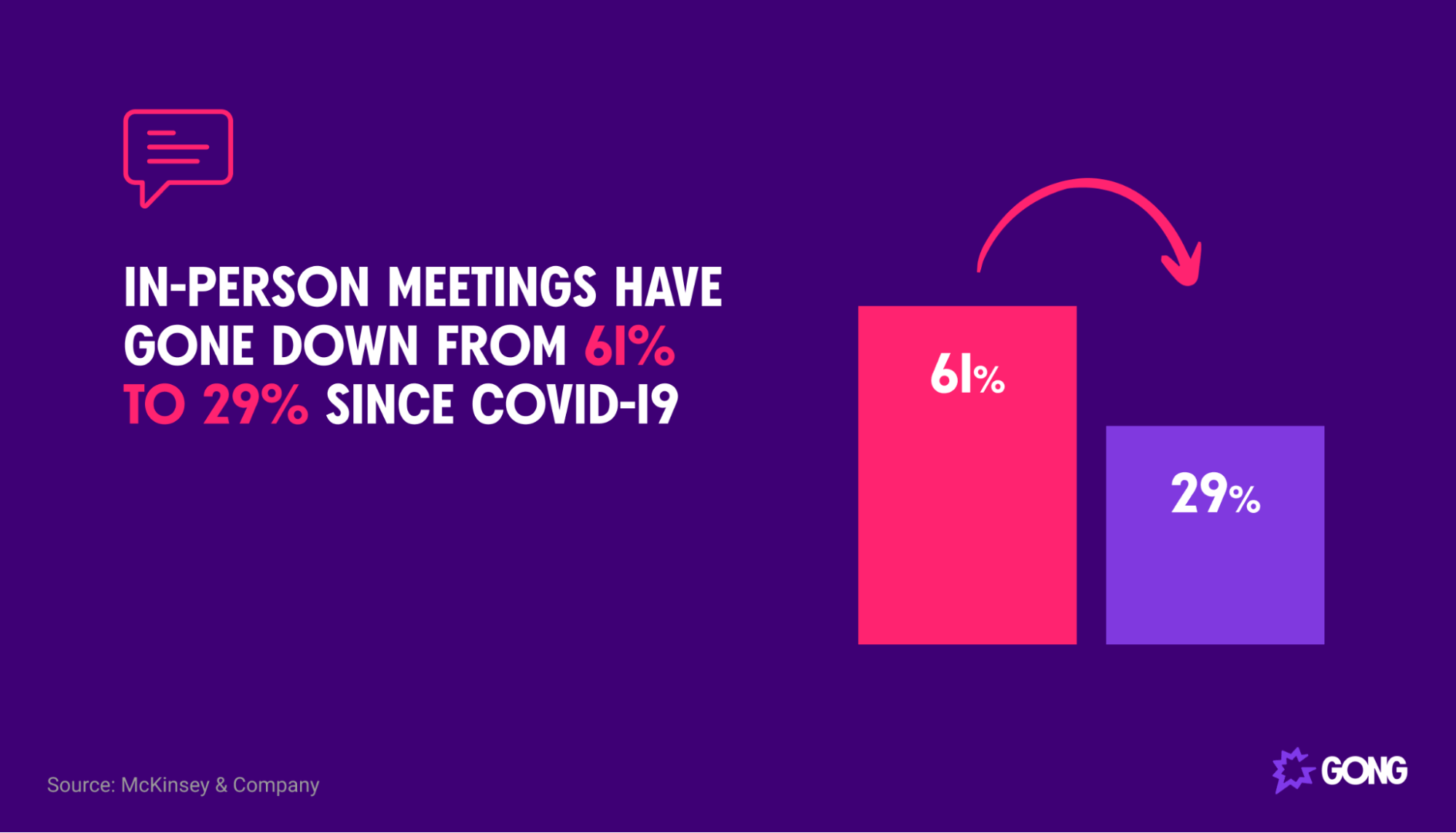
Video conferencing and online chat are the two dominant channels for interacting with B2B prospects. Digital interactions with remote sales reps have increased by 41% for video conferences and 23% for online chat.
Virtual meetings are here to stay, but they can be difficult to navigate. It’s important that you equip your sales team with the right virtual sales skills to thrive.
Buyers increasingly prefer digital interactions
70 to 80% of B2B decision-makers prefer remote interactions. They’ve grown used to it and like its flexibility in terms of scheduling.
What’s notable is that B2B buyers are comfortable with making big deals remotely. 70% are willing to make remote purchases over $50,000, and 27% would spend over $500,000.
Sales reps are more productive
67% of employees who worked at home during the pandemic were more productive, while 24% said their productivity was the same. 57% of employees say they’d prefer working remotely full-time.
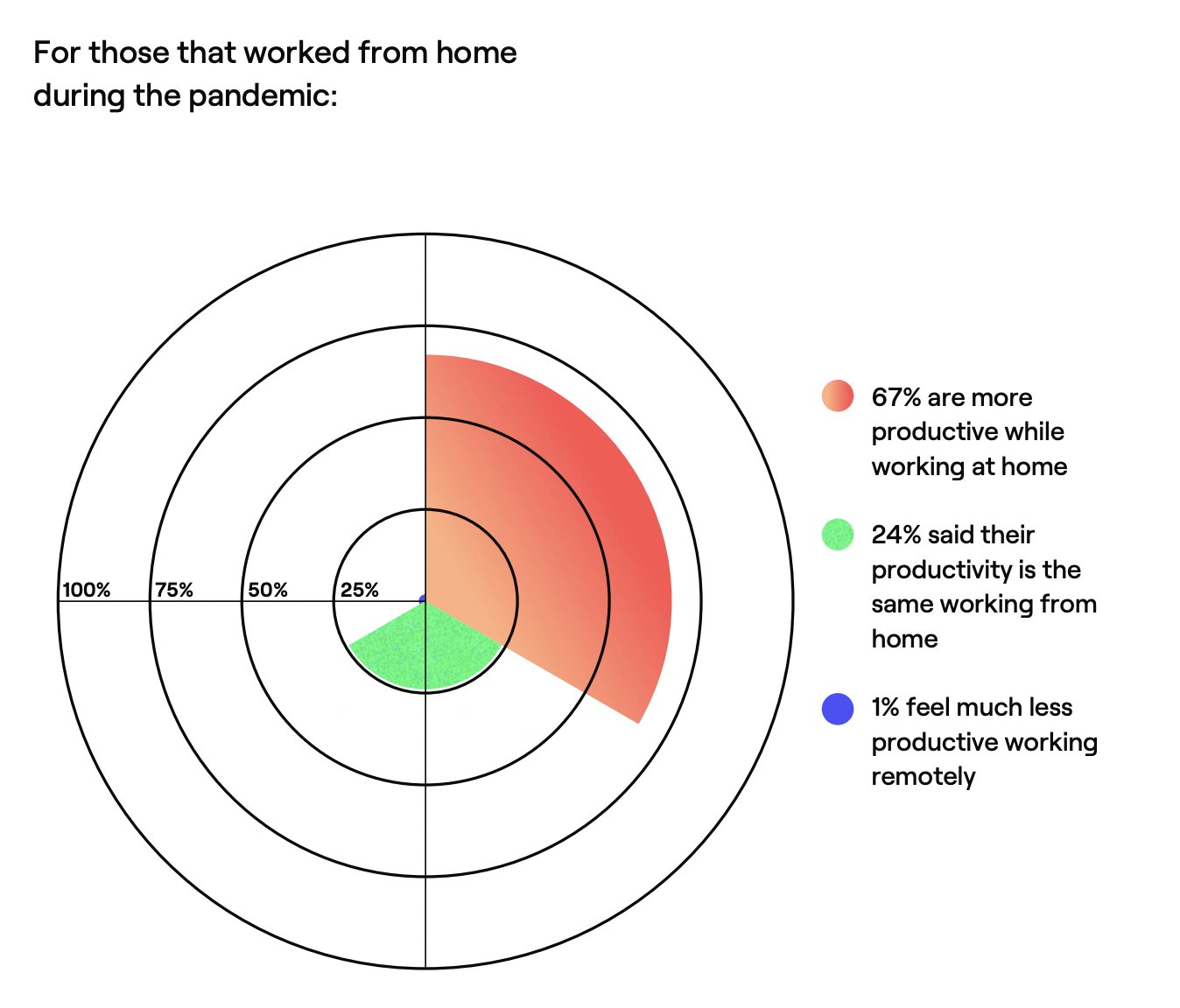
Remote selling gives your sales reps the flexibility to choose their work environment. They don’t have to waste time driving from prospect to prospect, which means they can focus more of their day on high-value tasks like booking meetings and closing deals.
Remote selling offers more data points
Remote sales means there’s no face-to-face interaction, but there’s an upside to this.
Using a sales engagement platform like Gong allows you to capture customer interactions across phone, email, and web conferencing. It analyzes those data points and uncovers valuable insights that can help refine your sales process.
Want to know what separates your top performers?
Gong shows you exactly what they’re doing differently, from the questions they’re asking to the topics they’re covering. With these insights, you can replicate their success across your team and push more deals through your sales pipeline.
The challenges of remote selling
Remote sales has its advantages — it cuts down on travel costs, increases productivity, and allows you to match your buyers’ preferences. However, sales tactics that work for in-person meetings don’t always translate well to virtual settings.
Here are some of the top challenges that sales reps face when selling remotely.
Keeping prospects engaged
67% of employees are distracted during online meetings — 55% admit to checking their emails, and 51% admit to using their phones.
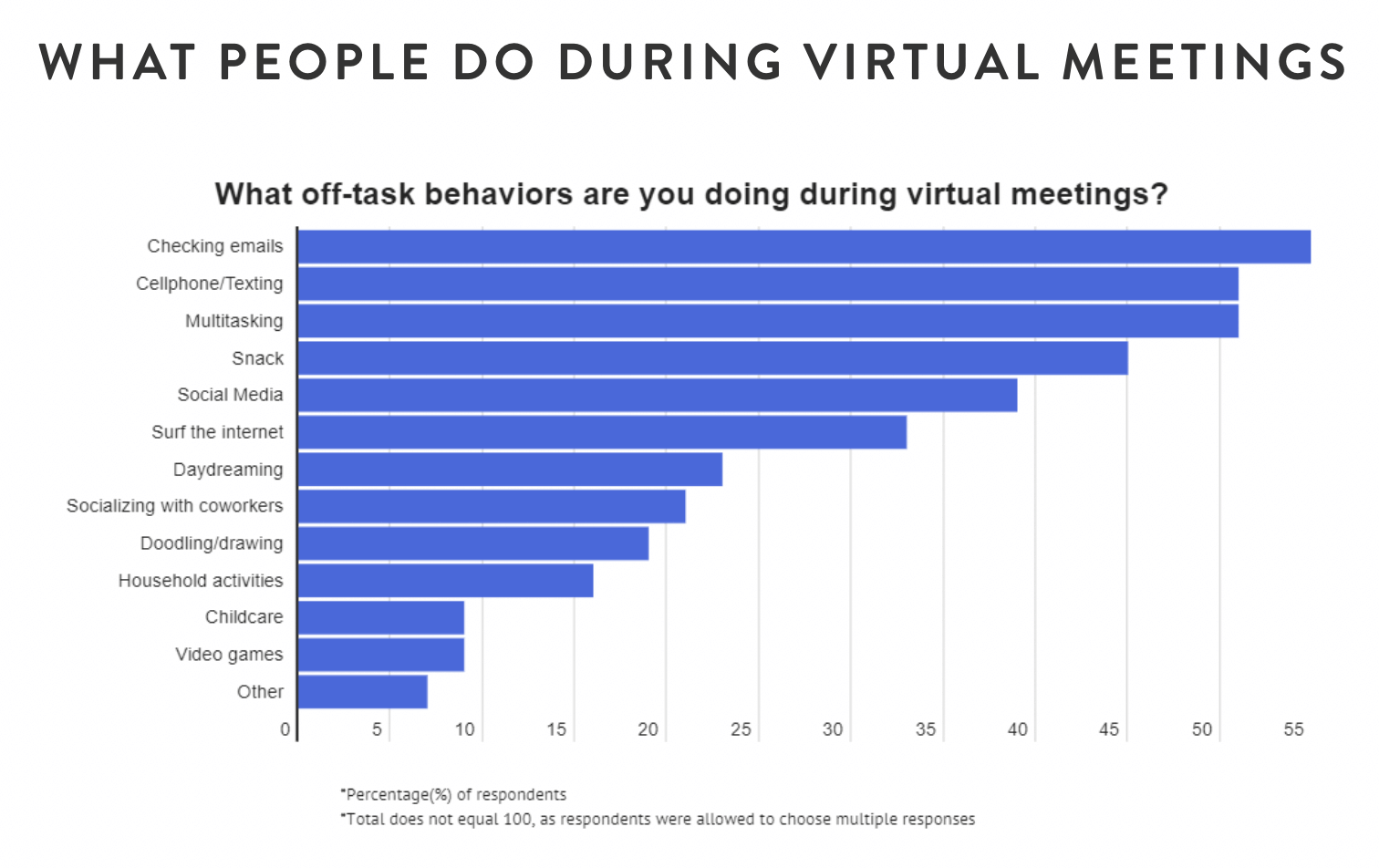
While you might be working in a distraction-free environment, that won’t always be the case for your prospects. They might be browsing their feeds or texting during a sales pitch, which means they may miss crucial details.
Training virtual teams
It’s easier to conduct sales training when your reps are in the same location. But training and aligning your team with your sales strategy becomes harder when they’re in different parts of the country (or world). This can result in inconsistent messaging.
Engaging buyers at the right level
Our data shows that win rates are 80% lower for small business deals when decision-makers aren’t involved.
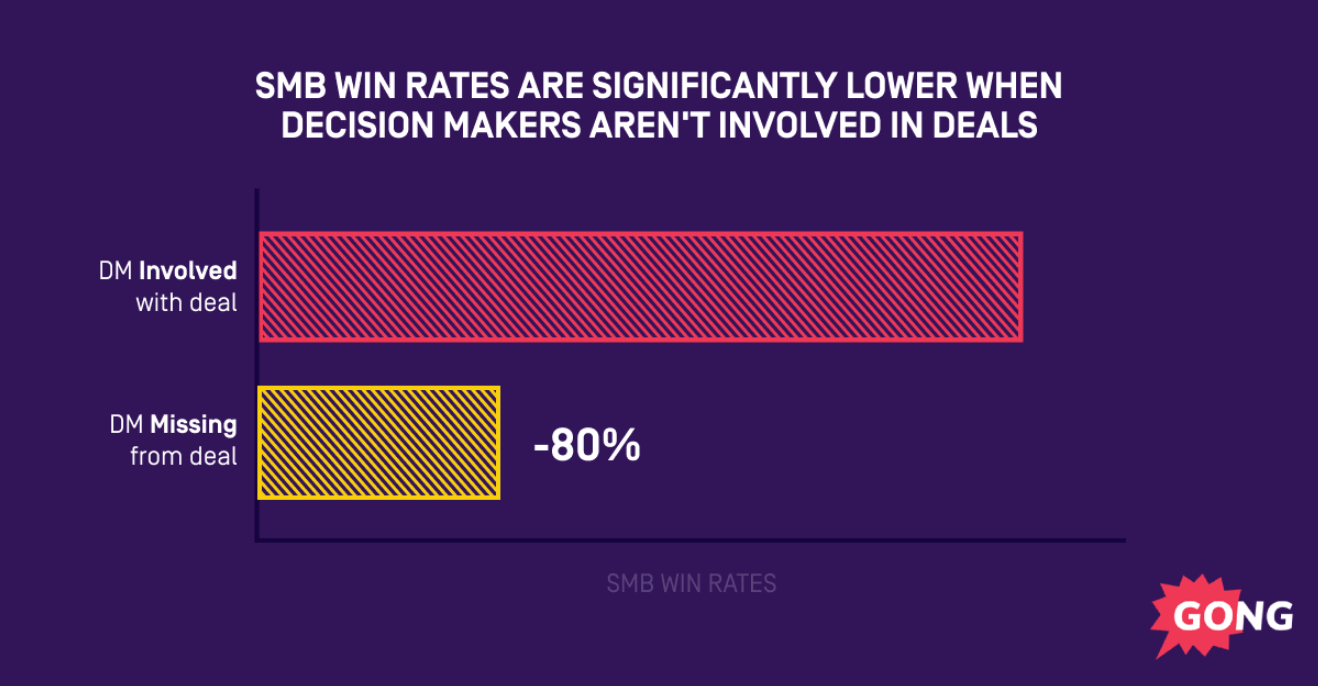
Involving a decision-maker is a must, but connecting with them is harder than ever. Before you can reach a CEO or a C-level executive, you’ll likely have to get through a gatekeeper (typically assistants or office managers) first.
Understanding deal risks
Shorter interactions with prospects mean there’s less time to surface potential threats that could derail a deal. These include competitors, shifting priorities, and budget changes.
Monitoring market shifts
Are your prospects facing new problems? Are their priorities the same, or have their internal timelines shifted?
Not meeting customers in person means these learnings can appear more fragmented than before. It also becomes harder to separate anecdotal evidence from a few reps from a larger shift in the market.
Lack of visual cues
In face-to-face meetings, visual cues like nodding indicate a favorable response, while eyebrow raising means you may need to clarify a particular point more.
Virtual meetings make it harder to gauge reactions, especially if prospects have their cameras turned off. The lack of visual cues can make it difficult for reps to tailor their pitch accordingly.
Technological issues
“Can you hear me?”
“Okay, how about now?”
A bad microphone or poor internet connection can affect the quality of your sales presentation and leave prospects feeling frustrated.

While buyers are often forgiving of technical issues, repeated hiccups can reflect poorly on your company.
Demonstrating product features
Certain products like Software-as-a-Service (SaaS) are well-suited for remote selling. But selling a physical product is much harder — prospects can’t exactly hold it in their hands and try it out.
But despite these challenges, best practices emerging every day, are helping reps to shorten their learning curve and allowing companies to leverage and amplify the benefits of remote selling.
Remote selling best practices to close more deals
Adopting a remote selling strategy can be difficult, especially if your reps are used to in-person meetings. But it’s increasingly clear that virtual selling is becoming the norm.
Help your sales team succeed with these remote selling best practices.
1. Set clear expectations
Setting clear expectations will keep your team on the same page and working toward the same goal. It will also help them maintain certain standards as they engage with prospects.
Start by setting objectives for each rep, but be clear here. Saying that you want a rep to “close more deals” is vague and confusing. Lay out performance goals and tasks that you want your reps to perform weekly or monthly.
Next, go over your sales playbook with each rep. This is a guide that details best practices for various situations — how to prospect, how to overcome objections, when to follow up, etc.
Finally, encourage your team to communicate regularly. Organize meetings through video conferencing tools and make sure your team knows what’s expected of them.
2. Develop product knowledge training
Sales reps must know your products or services inside and out. 65% of buyers said that strong product knowledge was a top reason for choosing a vendor over other options.

Strong product knowledge allows your reps to have engaging conversations with prospects. It also allows them to respond in more detail when prospects ask about certain features.
Reps should receive training in the following areas:
- Pricing
- Features
- Customizations
- Use cases
- Integrations
- Service support
- Upcoming updates
- Alternatives
Create resources like product videos, knowledge bases, and guides, and consider using a learning management system (LMS) to help your reps improve their product knowledge.
3. Revisit your sales onboarding process
A strong onboarding process improves your sales reps’ productivity and reduces the time it takes for them to close their first deal. However, as your company grows and changes its processes, it’s important that you revisit your onboarding process.
Have you implemented new strategies or discovered better ways to handle objections? Have you adopted new processes across your company?
With a sales enablement tool like Gong, you can build a library of call recordings and help new sales reps understand your sales process better. This will also help them learn what makes a great discovery or demo call.
4. Keep sales pitches to 9 minutes
We’ve analyzed over 100,000 virtual meetings and found that winning sales decks were 9.1 minutes on average. Lost deals had sales decks that were about 11.4 minutes long.
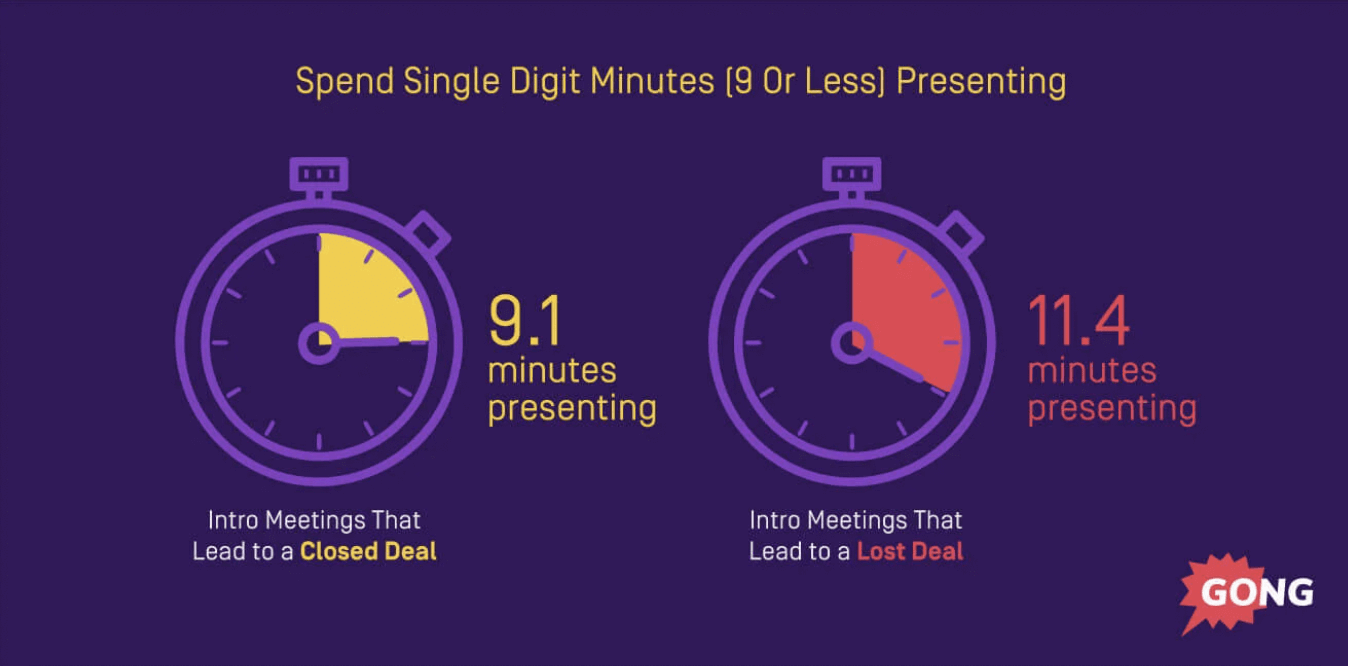
This is known as the “9-minute rule.”
If your sales reps are pitching for more than 9 minutes, they risk losing the attention of their prospects (and missing out on the deal).
Of course, this doesn’t mean that reps have to keep all sales decks to 9 minutes. It means they need to “wake” their prospects and keep them from getting bored. Examples include introducing a new speaker, playing a video, and sharing a compelling story.
Click here to get our free high-impact sales pitch template (with scripts).
5. Practice active listening
Active listening is a highly underrated sales skill. It involves truly listening to your prospects and making them feel heard. It also leads to more closed deals.
Our data shows that the top sales reps have a 46:54 talk-to-listen ratio during discovery calls, meaning they talk for 46% of a call and let buyers talk for the remaining 54%.
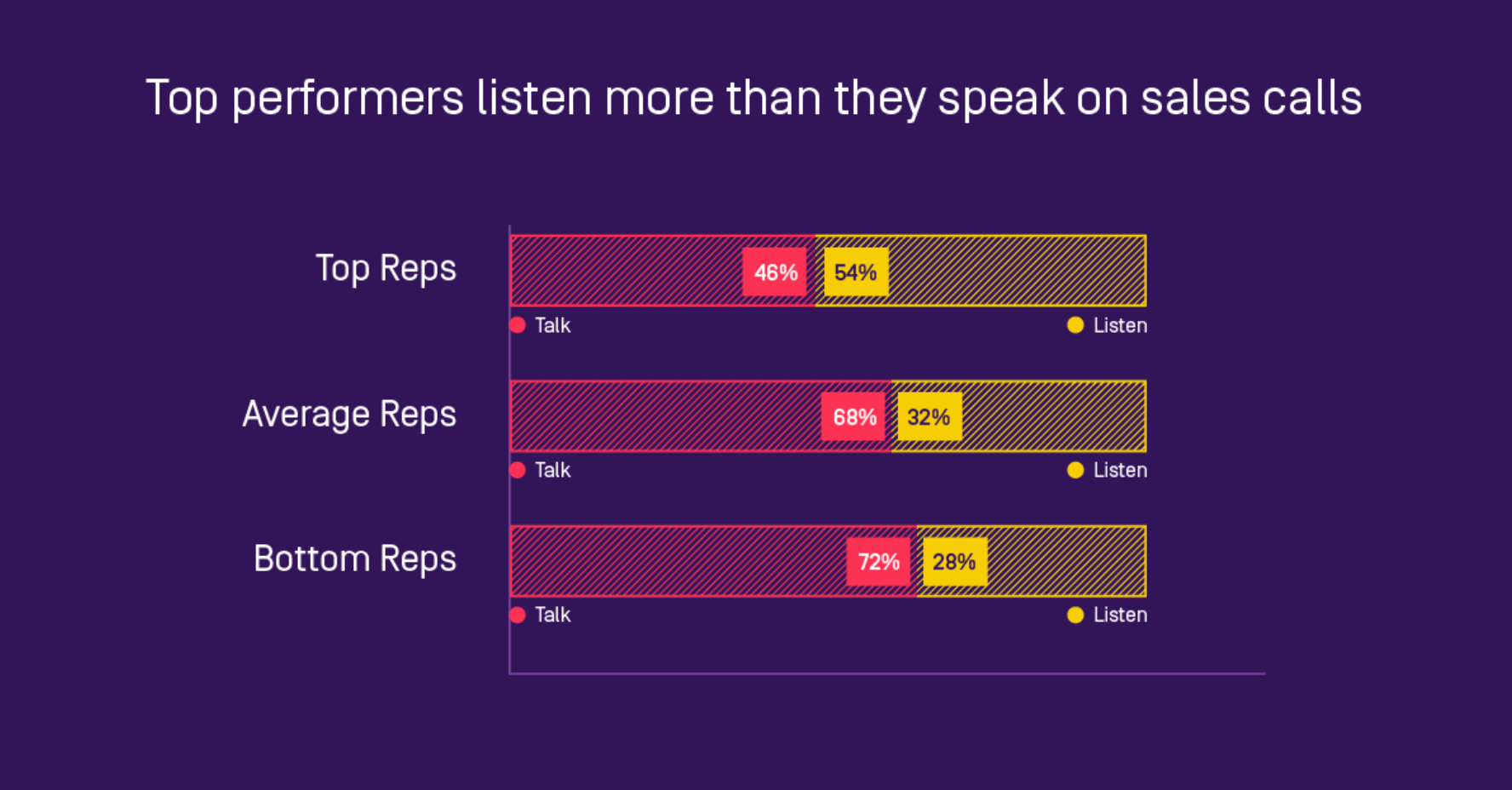
In contrast, lower-performing reps speak the majority (72%) of a call.
Have your reps practice active listening by asking relevant follow-up questions and “mirroring” their prospects or repeating back what they heard. This lets prospects feel heard and prevents any misunderstandings.
6. Turn on your webcam
Don’t let prospects stare at a black void.
Turning webcams on during virtual meetings is key to closing more deals. Prospects can see who’s on the other end, which helps build trust and rapport.
Win rates are 127% higher when webcams are active.
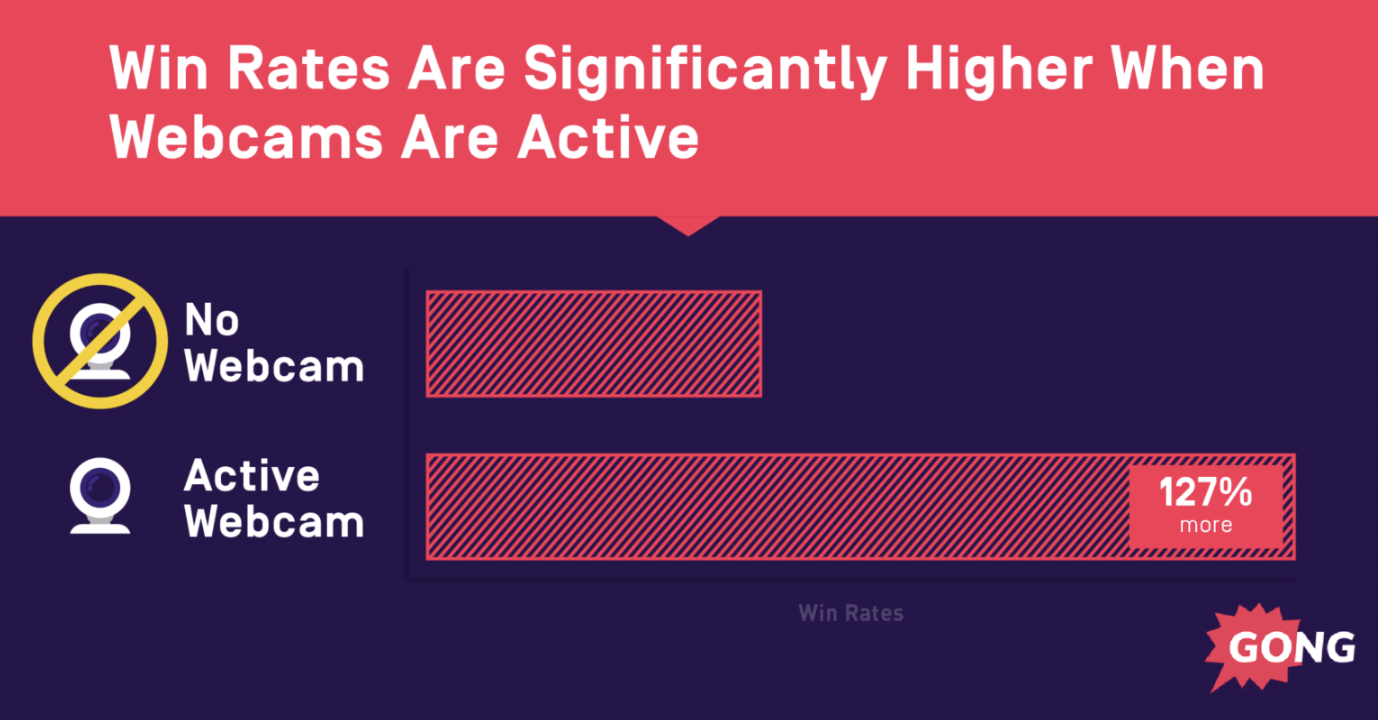
Encourage your reps to leave their webcams on. Better yet, provide them with our 9-point checklist for having great video calls.
7. Have weekly sales pipeline reviews
Conducting pipeline reviews helps you assess the overall health of your team’s pipeline.
There’s no rule on how often you should run pipeline reviews. But conducting them at least once a week will ensure alignment with your team.
Hold weekly virtual meetings with each rep and ask them to provide a summary of the deals they’re working on. What’s their current status? How likely are they to close? Are there any issues?
Remember to end each review with clear action items on what needs to happen next to move a deal forward. Examples include emailing relevant content, managing an objection, and bringing a decision-maker in.
Streamline weekly pipeline reviews and see how your team is progressing with our free sales pipeline template.
8. Track key sales metrics
Tracking key metrics is a must to improve your sales process. It allows you to measure sales performance and provides insights into what’s actually working.
Here are the metrics you’ll want to track and add to your sales report:
- Pipeline opportunities
- Pipeline coverage
- Quota attainment
- Participation rate
- Calls made and emails sent
- Meetings booked
- Opportunity win rates
Keeping an eye on these metrics will help you measure and improve performance across your team. For example, if a rep hasn’t been hitting their targets lately, digging into their sales activities can help you figure out why.
9. Use sales enablement software
How do you know if your reps are adopting talk tracks? How do you ensure they’re following best practices? And how do you identify areas they can improve in?
Sure, you can shadow calls, but it’s not exactly scalable. A better way to manage your remote sales team and improve their performance is to use sales enablement software.
A sales enablement tool like Gong captures customer-facing interactions, which allows you to analyze conversations and monitor talk track adoption. It also breaks down stats like talk ratios for each rep, so you can identify areas they need help with.
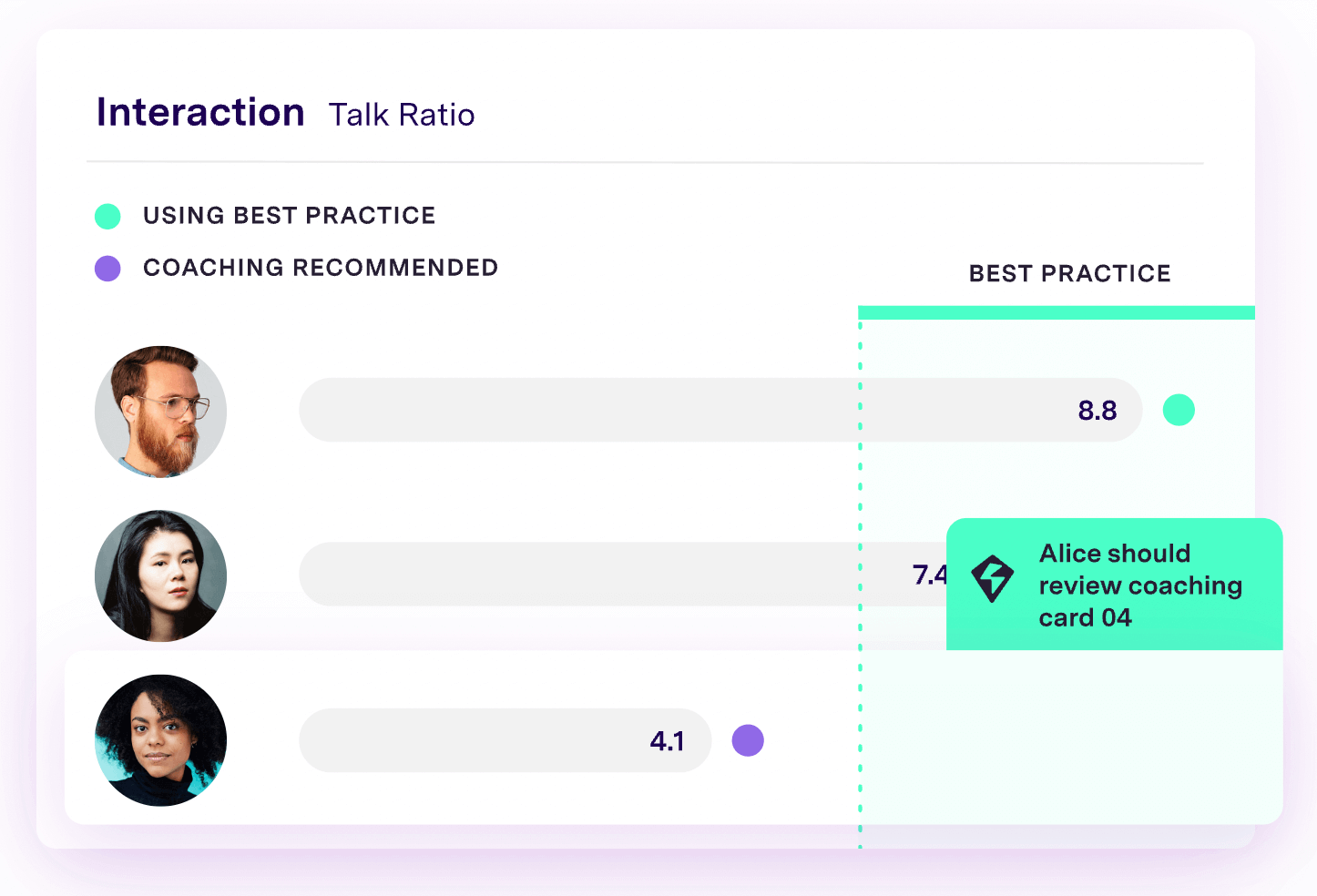
With these insights, you’ll be able to deliver personalized feedback and provide ongoing remote sales coaching — both of which are key to boosting performance across your team.
Take your remote sales strategy to the next level
The global pandemic has forever changed the traditional sales model.
B2B buyers not only prefer digital interactions over in-person meetings, but they’re also comfortable making large purchases. Organizations with a solid remote selling strategy in place can prepare for this shift as more deals take place online.
Of course, managing a remote sales team isn’t easy. But with the right tools, you can turn your team into superstars.
Gong’s sales enablement software helps you maximize your team’s productivity — analyze customer interactions, monitor sales activities, see what sets your top performers apart, get data-based insights for each rep, and more.